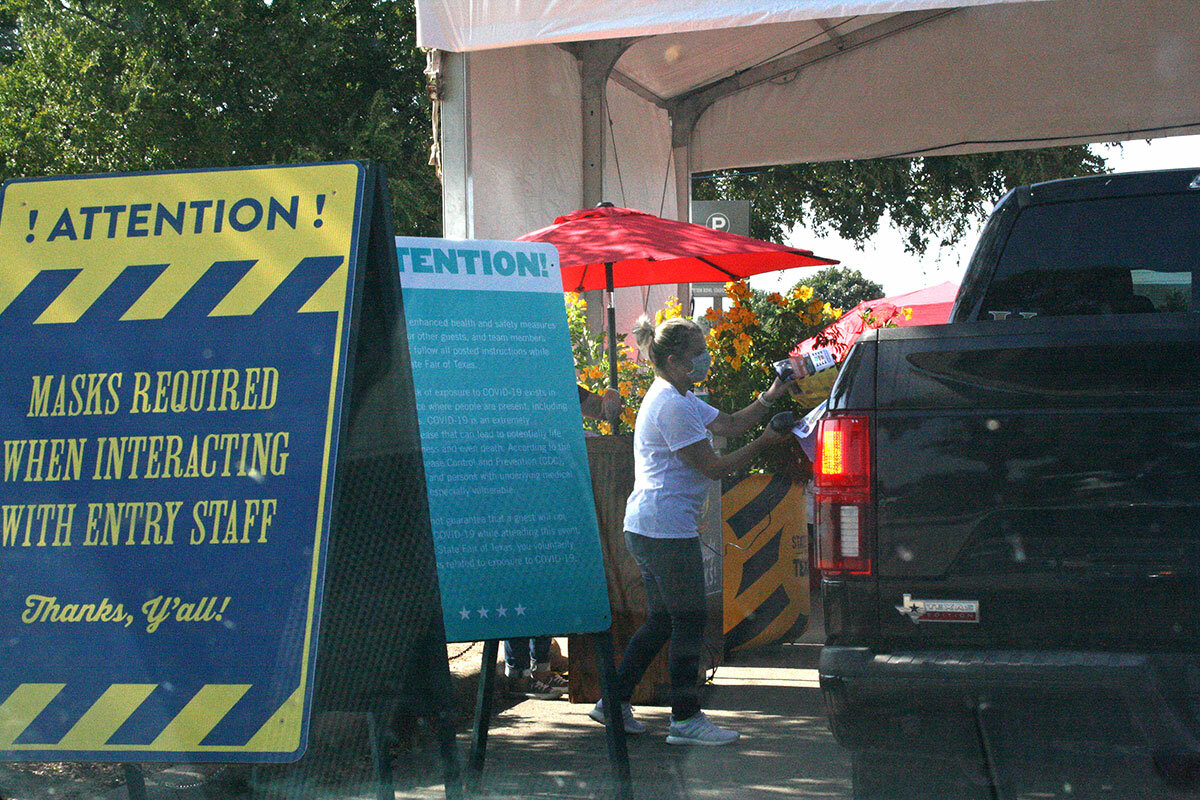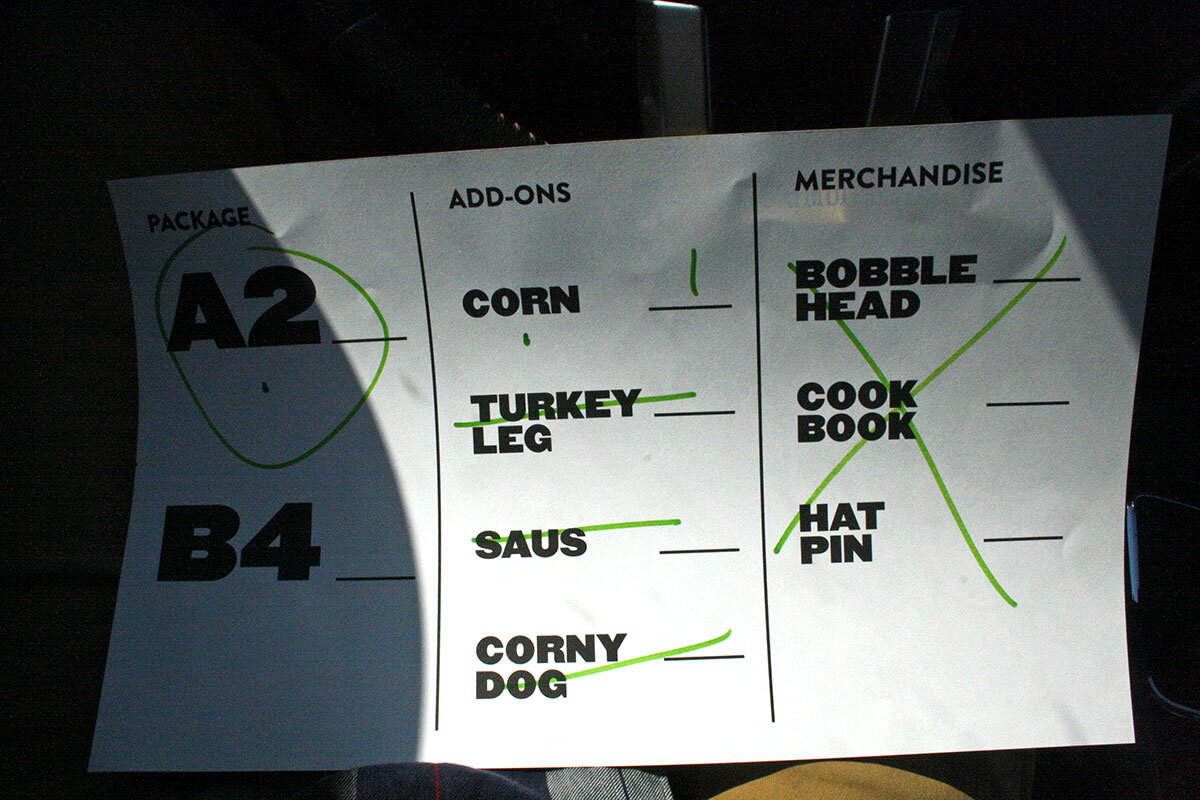Drive-thru Texas state fair: fried Oreos, yes. Baby animals, no.
Loading...
| Dallas
It’s a warm, sunny day, and the drive north up Interstate 35 is as smooth as you can expect that drive to be. It’s going to be a good day, reader.
It’s late September, which for 134 years has meant one thing in Texas: the start of the state fair.
This year is the Plague Year, though. Recreation has been banned, frivolity outlawed, until the curve is as flat as a half-empty Topo Chico left in the sun.
Why We Wrote This
The state fair – in whatever state – is an American tradition. And our Texas correspondent reports that despite a long line, a $65 entry ticket, and his first-timer's skepticism, the new socially distanced drive-thru event is still a communal experience.
Still, this is my first state fair. I grew up in England, and deep-frying everything was, I’d thought, an exclusively Scottish pastime.
I’ve wanted to visit the State Fair of Texas since I moved here in 2017, since I’d read about the funnel cake bacon queso burger and the time Big Tex burst into flames.
But one does not simply move to Texas and reach straight for the funnel cake bacon queso burger. One spends years building gastrointestinal resiliency, as I have. Now it’s 2020, so this year’s offerings are more limited, and available only via drive-thru. My ticket guarantees me a corn dog, fries, cotton candy and deep-fried Oreos.
Traffic is beginning to swell as I peel off I-35. A Ferris wheel towers above the trees, “TEXAS” emblazoned on its spokes. Enter Fair Park through Gate 11, the ticket instructs. We obey, but the line to enter begins at Gate 5. My girlfriend – here for corn on the cob, not to be quoted in this report – let out a snort of frustration. It is just past noon.
Reader, our frustrations are only just beginning.
We’re in the parking lot now. It’s 1:30 p.m. Another snort of frustration. My girlfriend slips out of her shoes and opens a book.
The cars snake across the concrete in a long, curving U. We’re following a silver Chevy Tahoe. Peering into the other cars – there is nothing else to look at – I see smiles and laughs. I feel the same. The line is long, but it’s moving.
It is a warm sunny day. The Texas summer heat has broken, finally. Or is that just the air conditioning? No, I taste the cool air as I lean out the window to photograph the chain of taillights in front of us.
People are getting out of their cars, even though signs say you shouldn’t. They’re going to the portable toilets. Or walking aimlessly. One man is pushing a stroller.
I take more pictures of lined-up cars, through the car windows this time. Something more artsy.
I should mark the time we entered the gate, just in case!
The line splits into two lanes. Now we’re behind a black Ford F-150 Texas Edition. It’s a bit dustier than the Tahoe. Or is it a clean car viewed through a dusty windshield? As I’m about to say something to my girlfriend about perspective, a car breaks out of line abruptly and heads for the exit.
Strange. It feels like we only just entered Gate 11, just like it feels like it was only March last week! We should play a game, I say. She suggests alphabets, and we hunt surrounding license plates for A’s, B’s, C’s, D’s, etc.
There are no I’s in Texas license plates, apparently. Is there some kind of ban? Do they look too much like a “1”? The game ends.
Oh look, Big Tex! Or a mascot, at least. Children spill out of cars to take pictures with him. That’s nice. I wonder why I can’t yet see the real Big Tex, given he’s a 55-foot-tall animatronic cowboy.
Can you get sunburn through car windows? The back of my shirt is very sweaty. “Wash me” is written in the dust of the F-150 Texas Edition’s tailgate, I notice. My girlfriend has gone for a walk. She’ll be back soon!
More cars left. My surroundings have transformed. They must be photographed, I know. But I’m not sure why.
Right, the reporting trip. Reporting trips have been rare this year. That dining room table was starting to feel claustrophobic! Ah look, my girlfriend is back. And look, we’re at the fair entrance! And it’s not even 5 o’clock!
Fries: Good. Remind me how hungry I am.
Corn dog: Tasty, but dense: B–.
Corn on the cob: Good, my girlfriend says. She eats only one.
Deep-fried Oreos: The highlight. Must inform Scotland.
“With it being a new event it comes with its challenges,” Karissa Condoianis, spokesperson for the State Fair of Texas, tells me a few weeks later. “We’ve fixed it now.”
The lines are shorter now, she says. But while they don’t know how many people are in each car, overall attendance is down too, from more than 2.5 million last year to about 30,000 cars for the four-weekend event that ends Oct. 18.
It’s part of an attempt to replace the fair in aggregate. There’s been a shortened market week and some virtual events as well. The organizers know it’s not a perfect substitute, says Ms. Condoianis, but “it was more about keeping the state fair spirit alive.









